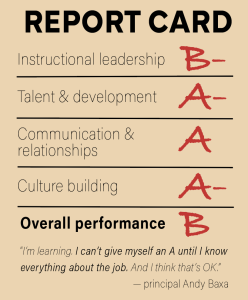On July 10, Andy Baxa was named principal of McCallum, stepping into a role that he had been working toward since he accepted his first position at the school, 20 years earlier. In the days that followed, Baxa got to work on his plans for the school year ahead.

Oct. 18, marks his 100th day as principal. In the same way that a president is evaluated at the beginning of a term, Baxa reflected on his progress in the four main categories of principal performance: Instructional leadership, talent and development, communication and relationships and culture building.
Instructional Leadership: B-minus
The first category examines a principal’s ability to innovate learning to the school with new methods. Examples of success include researching best practices for instruction and cultural responsiveness, looking at data sources to maximize student growth and providing relevant and professional learning.
According to Baxa, this area had to take a backseat until beginning-of-year needs were addressed.
“It’s an important part of the job, but right now, we’ve been focused so much on the logistical aspects, the scheduling and trying to get everything running the way it should,” Baxa said.
Former principal Nicole Griffith isn’t worried about Baxa improving in this category.
“He’s one of the smartest people I’ve ever worked with,” Griffith, who is now the principal at Ann Richards School for Young Women Leaders said. “He’s like an encyclopedia of educational policy. If you need to know something, it just kind of lives up in his head.”
Baxa’s focus for instructional leadership centers around not only raising the percentage of students passing their STAAR EOC tests but also raising students reaching the mastery level.
“It’s not just enough to increase our percent passing if we’re not also increasing the percent of people reaching the mastery level,” Baxa said.
Last year, school administration worked on instructional leadership with the science team and directly saw a jump in mastery levels of the biology STAAR test. Baxa plans to apply this same focus to other subjects.
“A lot of times in instruction, you see teachers that teach to the middle,” Baxa said. “I want to challenge them to teach to the edges — the low and the high. Switching the mindset will push them to achieve at the higher levels.”
By just changing instructional strategies slightly, big jumps in student learning can be achieved, Baxa said.
“We’re working directly with teachers to find ways to scaffold the learning to meet the students where they are and move them to where we need them to be as quickly as possible. We realized that there might be some gaps in some of our education. That’s our job as teachers to address that.”
Talent and development: A-minus
The second category addresses the principal’s ability to encourage student and staff progress. Examples of success include building a collaborative environment to develop school goals and vision, ongoing teacher development and promoting student growth.
Griffith sees this area as a strength for her replacement.
“I think McCallum is in really good hands,” Griffith said. “I felt a lot better about the decision for me to step down from McCallum when they did end up choosing Mr. Baxa. They know and love him and have always been so supported by Mr. Baxa.”
Baxa says the hardest thing about being a principal is not being an assistant principal.
“Coming from AP to principal, you still have a little bit of that mindset of I have to do the AP tasks. It’s not really so much that there’s more stress, it’s about that momentary stress from one incident to the next and putting out the fires.”
According to Griffith, who made the shift from AP to principal when she came to McCallum, the difference between the two roles is most keenly seen by students.
“I think for students it’s a little harder because the job of the assistant principal is discipline,” Griffith said. “That’s not a part of a principal’s job near as much. That can be hard for students to see that person as a principal.”
Currently, improvement in this area has centered around training the APs, three of which are new to McCallum and two of which are new to AISD. This process includes weekly meetings to discuss their individual responsibilities and get them up to speed on school-specific procedures.
“I’m really enjoying the fact that three of our APs are new to our campus,” Baxa said. “So that brings a fresh set of eyes to look at some things that maybe we were unaware of. ”
Communication and relationships: A
The third category measures the principal’s ability to connect with the school community. Examples of success include creating positive professional relationships with colleagues and families and making an environment where all staff feel welcome.
Communication comes naturally to Baxa. Throughout the day, he gets out of his office to interact with students and teachers. Every 30 minutes or so, he makes it a point to go around the school to walk into classrooms and observe different classes.
“The best part is getting to connect with students on a different level,” Baxa said. “Not as the disciplinary person, but just as the person who wants to support you in your academic endeavors throughout the school.”
Student Body President Olivia Hexsel finds this aspect of Baxa’s leadership most helpful in his transition to the new principal.

“He is very strict, but he is also always welcoming to our community,” Hexsel said. “At McCallum, we are a very diverse community. That’s one of the reasons why I came to Mac. [Mr. Baxa’s] been so welcoming to new students and everyone.”
According to Griffith, communication has always been Baxa’s strength.
“He leads with a lot of empathy,” Griffith said. “He really understood and tries to understand the perspective of other people as he’s working through issues. He made sure to say ‘I’m really sorry that that happened to you,’ because so much of being a principal and an assistant principal is conflict resolution. People usually don’t come to you until something’s not right. That’s just the job of an administrator at the end of the day.”
Baxa has also incorporated a weekly newsletter that goes out to parents in an email on the weekend.
“My communication strategy is that you can’t over-communicate,” Baxa said. “Some people may get annoyed with the emails, but there’s going to be somebody in that chain who appreciates the fact that that information is coming and appreciates the fact that we’re keeping them informed.”
Culture building: A-minus
The final category considers the principal’s ability to create and facilitate a school identity. Examples of success might include efforts for embracing all voices in the school community, promoting systems that encourage outreach with the community, having high expectations and empowering students and staff.
After 20 years working at the school, Baxa understands the importance of culture. For students, this has helped facilitate a smooth transition between principals.
“He knows how the McCallum energy flows,” Hexsel said. “It’s not like someone coming in new from a totally different environment.”
Baxa’s entire educational career has been at McCallum. From his time as a student teacher to his current role as principal, he has invested in the school.
“He really tries to encourage the student body to go to events, go to homecoming and go to games,” Hexsel said. “It’s really important to build that school spirit because I think that is what makes Mac whole.”
Baxa agrees. He has no intention of making sweeping changes that would impact the culture of the school.
“We support and love our students,” Baxa said. “I definitely think that message is clear. But there are some little tweaks we have to do.”
This starts with a freshman seminar to discuss norms and explain how the school works. A key aspect of this includes input from senior leaders who, according to Baxa, are integral in bringing new students up to speed.
“Our students are doing a good job on educating [the freshman],” Baxa said. “Hearing from us is one thing, but hearing from students is completely different.”
Overall performance: B
The combination of these four categories makes up the criteria for overall performance, taking into account both timing and progress.
“I’m learning,” Baxa said. “I can’t give myself an A until I know everything about the job. And I think that’s OK.”
But a B for Baxa, earned after only 100 days, is alright by him because he’s playing the long game and is committed to the success of the school.
“The school itself is a unique place,” Baxa said. “It’s someplace that I’ve been able to grow and learn and develop as an educator. It’s taken care of me over the years, so I want to take care of it.”










Jeff H • Dec 4, 2023 at 9:18 am
Mr baxa is horrible at his job
Vivian Moore • Nov 24, 2023 at 5:05 pm
I like that this story uses Baxa’s perspective on his own performance rather than just known facts. The use of a report card is also a clever and interesting way to convey the information.
Elli Grace • Nov 7, 2023 at 5:20 pm
This story is very helpful and informing. This really shows how Mr. Baxa plans on helping the school in the future and gives us an idea of him as a principal.
Seamus Dillon • Nov 1, 2023 at 11:46 pm
I think this story is great because it shows a lot about Mr.Baxa that people might not have known (especially freshman) . For example, i did not know that baxa has been here for so long and that he was an AP before this year.
piper lynch • Nov 1, 2023 at 11:23 pm
I think this was a very clever article, and enjoyed how they used grading to relate to the school. The article was good in showing Baxa’s perspective on his effect on the school. I feel it would be cool to do a follow-up article at the end of the year.
Katie Hyzak • Nov 1, 2023 at 2:49 pm
I think that this is a great topic to cover. The way the story was layed out was very orderly. Lastly, I think that it was a good idea to interview an upperclassmen. As a freshman, I do not really know Mr. Baxa that well, and hearing that he has “helped facilitate a smooth transition between principals” makes me feel like he knows what he is doing.
Jennipher J • Oct 23, 2023 at 8:53 pm
I think he is doing an amazing job.